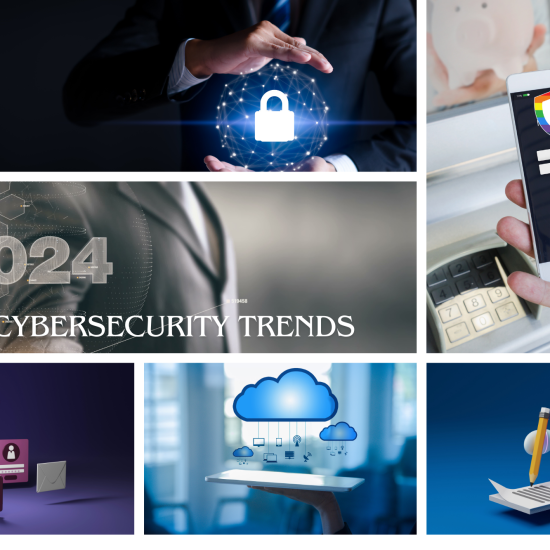How can banks strengthen security without compromising on performance?
Financial Institutions are and will be the number one target of cyber criminals considering the reward of data and most importantly, money. Cyber security is not only restricted to IT organizations but is also important for every single business. But, for banks, it holds important value. Banks deal in millions of transactions regularly. Hence, banks need to take protective security procedures to safeguard their data against cyber-attacks.
In this article, you will read about:
What is cybersecurity in banking?
Recent cybersecurity attacks in the Financial Sector
Top Cyber Security Threats Faced by Banks
How can banks improve their cybersecurity posture?
How can Rainbow Secure help?
What is cybersecurity in banking?
Cybersecurity in banking is concerned with protecting the customer and their assets, as well as the bank’s resources. Cybersecurity incidents can be extremely costly, time consuming and lead to regulatory fines or other legal action by aggrieved customers.
According to a recent International Monetary Fund (IMF) survey of 51 countries.
- 56 percent of the central banks or supervisory authorities do not have a national cyber strategy for the financial sector.
- 42 percent lack dedicated cybersecurity or technology risk-management regulation, and 68 percent lack a specialized risk unit as part of their supervision department.
- 64 percent do not mandate testing and exercising cyber security measures or provide further guidance.
- 54 percent lack a dedicated cyber incident reporting regime.
- 48 percent do not have cybercrime regulations.

According to a report from Trend Micro, in the first half of 2021 alone, ransomware attacks in the banking industry increased by a whopping 1318% which was disproportionate to other industries. The New York Federal Reserve noted a report that financial firms experience cyber-attacks 300 times more than other industries – highlighting how attractive this sector is to cyber criminals.
Staying informed about the risks of cyber security has been an important regulatory requirement for financial institutions in the United States. They are also required to report anything that may potentially occur and anything that could affect the USA’s financial sector’s stability. These types of events include banking cyber security risks such as hacking, ransomware and distributed denial of service (DDoS) attacks. Similar rules are also coming into effect in the UK, Europe, and Australia.
According to the American Bankers Association, eight out of 10 bank board members and executives that it surveyed said their bank had increased its tech budget in 2022 to invest in bank cyber security.
Recent cybersecurity attacks in the Financial Sector
Let us go through some recent cybersecurity attacks in the Financial Sector which highlight the need to adopt cybersecurity best practices to stay secure and operational. Some of the biggest cyber-attacks include:
- Accellion
While Accellion is a provider and developer of accounting software, a zero-day exploit in their Accellion File Transfer Appliance software gave hackers access to the databases of numerous banks and financial institutions. This cyber-attack on the banking industry technically occurred at the end of 2020, but much of the fallout wasn’t seen until after the New Year.
Some of the affected organizations include:
Morgan Stanley
Flagstar Bank
Reserve Bank of New Zealand
Australian Securities and Investments Commission
2. PayPal
The popular online payment platform, PayPal, experienced a new wave of SMS-based phishing attacks in 2021. In these cyber-attacks on the banking industry, the hacker or malicious actor impersonates PayPal while requesting users to verify their identities. This is a social engineering attack known as “quid pro quo,” where the attacker offers some service to convince victims to divulge sensitive data.
However, the verification site isn’t on PayPal’s domain, and any data entered is sent directly to the hacker instead.
3. A ransomware attack on Flagstar Bank in the USA in 2020 where hackers posted personal details of the bank’s customers online to attempt to extort money from the bank.
4. The New Zealand Stock Exchange had to shut down operations in 2020 following an extended DDoS attack on a network provider.
5. In 2021 online stock trading platform Robinhood experienced a data breach where the personal information of 7 million customers was accessed by a cybercriminal.
6. Ecuadorian bank Pichincha Bank was hit by a cyber attack in 2021 which resulted in disruption to customers’ ability to access banking services.
It becomes all the more necessary since the very foundation of banking lies in nurturing trust and credibility. Here are five reasons why cybersecurity is important in banking and why it should matter:
- Everyone seems to be going cashless, using digital money, e. debit cards and credit cards. In this context, it becomes very important to ensure that all measures of cybersecurity are in place, to protect your data and your privacy. Cybersecurity in the BFSI has become complex. Customers prefer digital banking. 78% of Americans prefer digital banking via mobile apps. To stay competitive, fintech firms are shifting to digital. Their digitalization market size will reach $29.97 billion by 2025. Their security landscape is also changing. The cyber threats against BFSI are witnessing a surge.
- Data breaches can make it difficult to trust financial institutions. For banks, that’s a serious problem. A weak cybersecurity system can amount to data breaches that could easily cause its customer base to take its money elsewhere.
- You often tend to lose time and money when a bank’s data is breached. Recovering from the same can be time-consuming and stressful. It would involve canceling cards, checking statements, and keeping your eyes open for complications.
- Your private data in the wrong hands can do great harm. Even if the cards are canceled, and fraud is immediately taken care of, your data is sensitive and could reveal a lot of information that could be used against you.
- Banks need to be on their guard more than most businesses. That’s the cost of holding onto the kind of valuable personal data that banks do. Your data with the bank can be breached if not protected from cybercrime threats.
Any successful cyberattack has the opportunity to affect people, processes, and technology throughout the organization. In the wake of an attack, banks need to get IT systems back up and running, but they also need to reassure customers and regulators, deploy effective backup systems, and potentially compensate for losses. This calls for planning, cooperation, and communication between operational, risk, infrastructure, and cybersecurity teams.
Top Cyber Security Threats Faced by Banks
Over the last couple of years, cybercrimes have become very prevalent in the financial sector that it is now believed one of the industry’s greatest risks. Hackers have advanced in technology improving their skills, making it very challenging for any banking sector to stop the threat each time. Here are some cyber security threats faced by banks:
Phishing
Phishing means to get confidential, classified data such as credit, and debit card details, etc. for malicious actions by hiding as a reliable person in electronic interaction. Online banking phishing scams have advanced constantly. They seem genuine, but they trick you into providing away your access data.
Malware
End-to-end customer appliances like computers and mobile devices are largely used for performing digital transactions therefore, they should be secured. If it is associated with malware, then it may cause a severe risk to the bank’s cyber security whenever they link up with your network. Confidential data goes through this network, and if the user device has malware fitted in it, with no security that malware can create a serious threat to the bank’s network.
Unencrypted Data
It is one of the most frequent threats encountered by banks where the data is left unencrypted, and cyber attackers or hackers manipulate the data right away, thus creating serious issues for the banks. All information that is kept on computers in banks or online should be fully encrypted. It will guarantee that even if the data is robbed, hackers may not be able to utilize them.
Spoofing
This is one of the latest forms of cyber threats faced by financial institutions. The hackers will pose as a bank website’s URL with a website that is related to the original one and works the same way and when the customer enters his or her login records the login credentials are robbed by these hackers and they use it later.
Data Manipulation
A widespread misunderstanding about cyber attacks is that they are only worried about data stealing. This is not always the case, however, as data manipulation attacks have gradually become a more common means of attack for hackers. Data manipulation attacks take place when a dangerous actor gains entry to an objective system and creates unnoticed changes to data for their gain.
Ransomware
Ransomware has been a major headache for organizations around the world for several years now. This is a method of cybercrime where files are encrypted, and users are locked out, with the criminals demanding money to re-access the system.
Organizations affected by ransomware attacks can find their systems crippled for extended periods, particularly if they don’t have backups. Paying ransom to these criminals is also not guaranteed to result in your system’s access being restored.
Ongoing risks from remote work
As the pandemic enters its third year, the reliance on remote work, hybrid workforces, and cloud-based software systems has become almost ubiquitous. This also means that financial institutions have more potential cybersecurity vulnerabilities than ever before.
Cloud-based cyberattacks
As more software systems and data are stored in the cloud, cybercriminals have seized upon this, and as a result, an increase in cloud-based attacks has been one of the most prevalent cyber threats to the banking industry. Banks need to ensure that the cloud infrastructure is configured securely to protect from harmful breaches.
Social engineering
One of the biggest recent cyber threats to banking and finance is social engineering. People are often the most vulnerable link in the security chain – they can be tricked into giving over sensitive details and credentials. This can equally affect a bank’s employees or its customers. It’s important to keep your employees informed about social engineering tactics and how these threats continue to evolve.
Supply chain attacks
An increasingly popular method of malware distribution by cyber criminals is to target a software vendor and then deliver malicious code to customers and others in the supply chain in the form of products or updates that, on the surface, appear to be legitimate. These attacks compromise the distribution systems and enable cyber criminals to enter the supplier’s customers’ networks.
Human Error
The biggest cybersecurity threat is human error. It is people who ultimately put data and systems at risk either because they have been tricked into providing sensitive details, haven’t properly protected their passwords, have used weak credentials, has clicked on malicious links, or opened suspicious email attachments.
How can banks improve their cybersecurity posture?
Several proactive steps can be taken to improve cyber security for banking. Types of security in banking often include:
1. Create Robust Security Policies
Formal policies offer a solid foundation for risk management. When developing your security policies, consider setting clear goals, objectives, and expectations. Choose and implement security frameworks. Define security processes, procedures, and tools. Craft best incident response & disaster recovery plans. Continuously monitor security risks and update policies regularly.
2. Leverage AI, ML, and Analytics
Advanced technologies are playing a critical role in cybersecurity in Fintech. AI, ML, and analytics aid in proactive threat detection. Moreover, they ensure faster analysis of large volumes of data.
So you can detect, predict and prevent financial frauds, known security threats, emerging risks, unauthorized data access and usage, and anomalous activities he threats in real time.
3. Continuous Threat Monitoring
Attackers don’t take breaks or sleep. BFSI is the key vertical continuously under attack. Monitor your architecture for threats 24×7. Centralized visibility is vital for threat monitoring. Real-time alerts and triggers help you to improve cybersecurity in fintech.
4. Enforce Zero Trust
No one should have unverified access to your critical assets. Strictly enforce role-based, least-privilege access to stakeholders. Additionally, implement strict password and MFA policies. Use encryption to protect sensitive data and passwords.
5. Manage Third-Party Risks Effectively
BFSI sectors must use third-party components, services, and APIs. With the growing instances of supply chain attacks, you can’t ignore 3rd party risks. In addition, always choose partners after thorough vetting. Be sure to check their expertise in the BFSI industry.
6. Don’t Ignore Robust API Security
API risks and AppSec risks are different. With the growing use of APIs in the BFSI sector, you must manage API risks. Add managed API protection to boost your API security. It plays a vital role in cybersecurity in the banking and finance sectors.
7. Maintain Backups
Ransomware attacks increasingly target financial institutions. The best way to avoid paying the ransom is to have a backup. If you are under attack, you can recover with backups.
8. Create cyber awareness among employees
Phishing is a popular method to breach banking security. You must prevent the exploitation of human errors. Create a strong cybersecurity culture within your organization. Create a culture of cyber awareness.
How can Rainbow Secure help?
The right amount of data and system access to the right person or role at the right time is the key to organizations being able to use digital tools and platforms to serve the customer base and stay compliant.
Next Generation Rainbow Secure platform is a modern identity and single sign-on solution for your business across on-premises and cloud environments. It’s backed by an experienced team of cloud and security experts, years of innovation, and partnerships with leading cloud platforms. Rainbow Secure is a Leader in Smart and Secure Digital Solutions that work for you.
Secure Workforce & Customer Login Use Authentication Plug-in by Rainbow Secure to secure workforce and customer logins. In this plug-in, you get a multi-dimensional password, passwordless login solutions with AI monitoring, Risk Analytics, and location fencing.
IoT Friendly Security: IoT platform developers can secure their cloud endpoints, and user logins (both admin and customer) against unauthorized access and scripted malware attacks using easy-to-adapt and support multi-layer interactive rainbow secure authentication solutions and services that include but are not limited to security assessment, API Security, secure user onboarding, and risk analytics.
Secure Data and its Backups We provide Cloud-based data vault and data archive solutions backed by Microsoft Azure and secured by our authentication plugin and industry best practices to give you ransomware protection and help with data governance and disaster mitigation.
Database Security We provide technical consulting services to Secure Databases in the cloud and on-premise. You get the best protection for your data in databases using native and third-party security tools.
Meet Compliance Requirements: Use Authentication Plug-in by Rainbow Secure with your business application and in SSO (Single Sign-on) and meet industry standards and compliance regulations such as NIST, ISO, FTC, SOX, SOC2, CMMC, CMMI, HIPAA, PCI, and others.
Securely communicate and Collaborate: Use Secure Business Email by Rainbow Secure and get protection against account takeover, phishing, ransomware, and automated login cyber frauds. In this email, you get options to send encrypted emails, single sign-on with Office 365, and Google, and 1 TB one drive storage.
Connect Business applications: Get one unified login using Rainbow Secure Single Sign-On
Manage User Onboarding / Offboarding using Rainbow Secure IAM
Verify User using Smart Multi-factor MFA. Smart Multi-Factor Authentication from Rainbow Secure which adjusts to your use case, reduces the cyber liabilities of a business from stolen credentials and improves productivity, and enhances user experience.
Do you have more questions about how innovative, patented Rainbow Secure Solutions cater to all your Financial Sector needs for robust cybersecurity solutions to maintain business continuity while keeping all your confidential data secure? Contact us today. Email us at Hello@rainbowsecure.com







